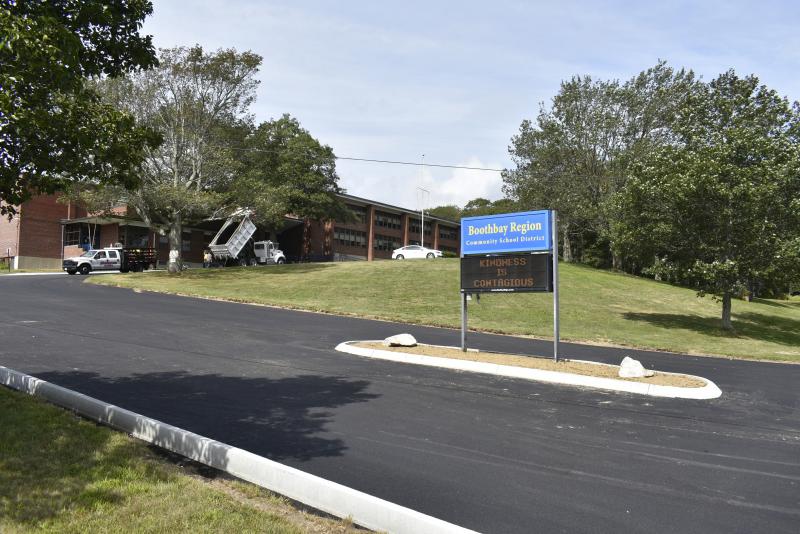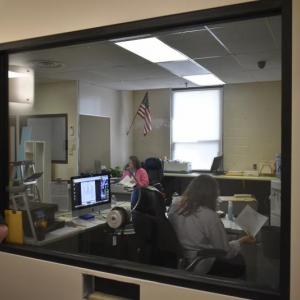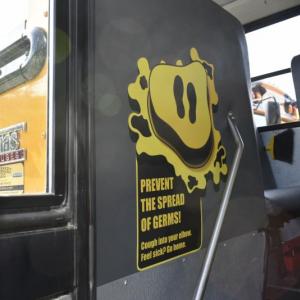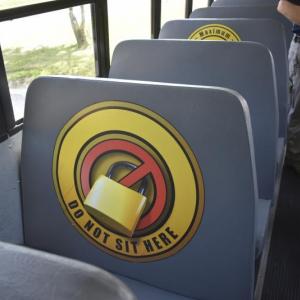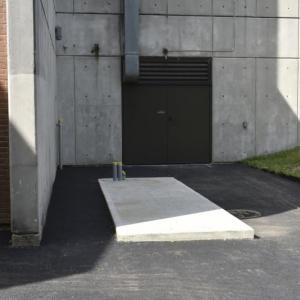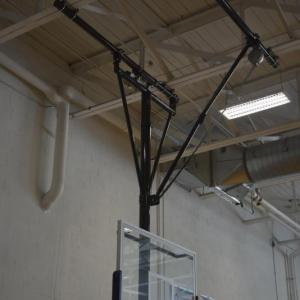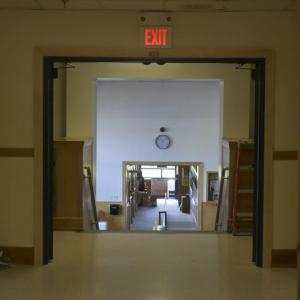As crews finish paving and landscaping the Boothbay Region High and Elementary Schools’ entrances, what can be seen isn’t all the Boothbay or Boothbay Harbor taxpayer gets. As the schools prepare for a school year which could change amid the pandemic, some of the work can’t be seen from the halls, much less the road.
Since the CSD took out a $5 million bond last April for major projects in the two schools, Alternative Organizational Structure (AOS) 98 Facilities and Transportation Director Dave Benner said much has been accomplished. Benner said general contractors and their crews have continued to work up to the last day to finish every project on time. And he said he and his custodial and maintenance staff have been working day and night to make sure every room meets COVID-19 precautions from the federal level down to the school administrative level.
“We've increased sanitization … There's a lot of signage. At the end of today, most of the little work should be done, Benner said Tuesday, Sept. 1. There are a few pieces of hardware that need to come, a little bit of floorwork that needs to happen and we need to get the last hall floor scrubbed and waxed, so we'll be working nights, over the weekends.”
This summer marked the second of two phases of projects. Benner said this year’s projects include sidewalk paving, curbing and portions of road paving throughout campus; replacement of interior doors and new trim work for BRHS; interior and exterior doors and new trim work for BRES, renovation of the school entrance, concrete work, partial roof replacement, a window for the assistant principal’s office, a new generator and new basketball hoops in the gymnasium.
Benner said while last year’s work was about students’ health, this year’s was about improving the buildings’ safety features.
“The whole thing is really about security. Before, you could come into (BRHS) and go anywhere you wanted to. Now you can't. The doors are shut and one button locks everything down. You can come in and go up and go down, but there's really no place for anyone to go.”
All exterior doors at BRES are new and all but one set are storefront or double-doors. In total, Benner said BRES has had about 40 doors replaced, though several others were passed over since they have been replaced in the past few years. The new generator is a 180 kW diesel generator with its own tank which will run the whole building for two to three days, an important factor as BRES is the regional evacuation center, said Benner. The old generator was only 55 kW which ran about 25% of the school.
The pandemic has added to health and safety concerns. Getting materials and supplies has been hard, too. Benner said plants shut down and, when products did become available, most were coming from foreign plants that reopened, and everything was still behind schedule.
“The two pull-down staircases came from Italy, so they were put on a container ship, they went out to the west coast and they sat out there under quarantine before they'd let them in.”
COVID-19 preparations
Last summer’s BRES projects included new HVAC units and installation. After applying H13 HEPA filters where possible, the updates are the first line of defense against COVID-19. Benner said the HVAC updates and other resealing and replacements have also saved around 25% in fuel consumption.
Every classroom will have its own hand sanitizer station and every sink its own handsoap dispenser. BRHS students will attend in two cohorts for two days a week each; BRES students will be separated by class and attend four days a week; and all are required to wear a mask and to socially distance at six feet when possible. BRES halls have markings on the floors and guideline reminders on the walls and doors. Water fountains are locked out of use, but the automatic dispenser for water bottles is still available and all students and staff are getting their own water bottles, said Benner.
One of the biggest items to address has been transportation: 169 students will need transportation, according to CSD surveys. With seven buses, few drivers, student passenger layout, and an hour for sanitizing, the CSD could only possibly manage 114 students without staggered bus schedules, according to a past committee meeting.
Luckily, bus layouts are now permitted for three feet between masked people rather than six feet. Benner said students will be staggered in a window-side/aisle-side seating arrangement which will increase the 12 to 15 passenger capacity to 20 to 24, depending on arrangements. The layout will mean every seat will have one student only except in the case of siblings; two seats behind the bus driver will remain empty. The driver will be protected by plastic shields to the rear and to the side of the seat.
Benner said in addition to the seating arrangements, the CSD has clinched two drivers who work at Country Coach Charters of Nobleboro and heard the CSD desperately needed drivers. If all goes according to plan, they will sign quarterly contracts, said Benner.
“It's all coming together, but it's just slow with all the unknowns. The principals, assistant principal and Security Director Kyle Canada are working some different traffic patterns … We're trying to separate the kids as best as we can so it isn't just a big herd of people.”
Benner said, as the first day of school, Sept. 8, approaches, he and his team and the contractors on-site have all been doing their best to get things done in time. “You make a list, look at your priorities and do the best you can and there's some give and take with all that stuff … Wherever we are on the (first day) is where we are. We just keep plugging away until we get everything where we need it.”


